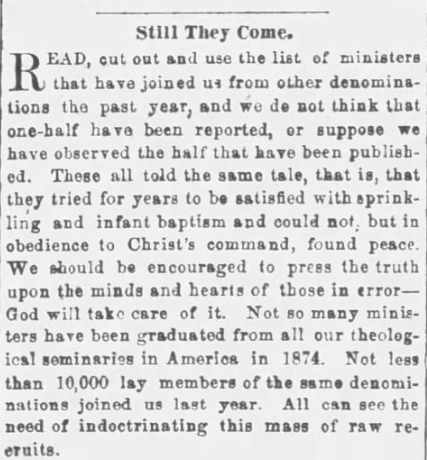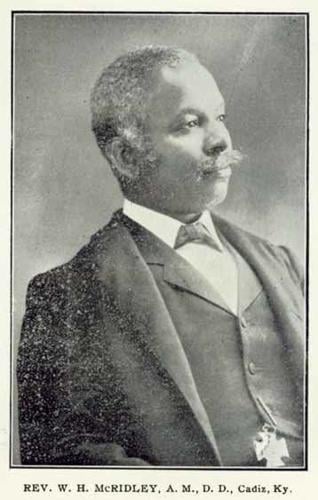Closed Communion, a Hallmark of Southern Baptist Orthodoxy
On June 24, 1851, a group of Southern Baptists met at Cotton Grove, Tennessee and passed the Cotton Grove Resolutions. These resolutions helped to begin the Landmark controversy among Southern Baptists. On one side were men who held strongly to landmarkism such as J.R. Graves, J.M. Pendleton, and A.C. Dayton. On the other hand, were men who strongly opposed the Landmark movement such as J.L. Dagg, R.B.C. Howell, and J.B. Jeter. Yet what is interesting is that while these men disagreed on the validity of landmarkism, they were all in total agreement in their opposition to open communion. This was virtually the unanimous position of Southern Baptists in the nineteenth and early twentieth century.
To prove this we can back up nine years before the Southern Baptist Convention was formed to 1836. That year the Baptist Union of England appointed two English Baptists to visit America and report on the condition of her Baptist churches. In their published report, “The Baptists in America: a Narrative of the Deputation of the Baptist Union in England, to the United States and Canada.” F.A. Cox and J. Hoby wrote, “The Baptists of America are almost universally strict communists, that is, they admit none to a participation with them in the Lord’s Supper, who have not been baptized or immersed.” (page 462) This report was published only nine years before the Southern Baptist Convention was organized in 1845.
One year after the Southern Baptist Convention was formed, R.B.C. Howell published the book “The Terms of Communion at the Lord’s Table.” Howell was a very influential Southern Baptists, as he pastored the First Baptist Church of Nashville, TN for over twenty years and served as the second president of the SBC. Howell strongly disagreed with open communion. He wrote, “Is the immersion in water, of a believer, by a properly authorized minister, in the name of the Father, and of the Son, and of the Holy Ghost, the only baptism? All Baptists reply in the affirmative. Then Pedo-baptists are not baptized. To commune with them, therefore, is to violate the law of Christ”. (page 217) Further Howell’s position was the standard for the day. He wrote of the practice of closed communion among Southern Baptists, “no association, nor even a single church, respectable for either numbers or intelligence, has, within the compass of my information, seceded from the great body of the denomination upon this ground.”
The first writing theologian among Southern Baptists after the Convention was formed was John L. Dagg. He authored “A Treatise on Church Order” in 1858. In the book he spends twelve pages defending closed communion. He says of the practice: “We are aware that the practice of strict communion is considered offensive by a large part of the Christian community. We lament this fact . . . But we believe that purpose for which the observance was instituted, and the divine will by which it ought to be regulated, require the restrictions under which we act.” (page 224)
During the early years of the Southern Baptist Convention, one of the most popular writers was J.B. Jeter. He edited the “Religious Herald” Baptist paper in Virginia from 1865 until his death in 1880. In 1876 he authored a series of articles on “Distinctive Baptist Principles” that were later republished in the book “Baptist Principles Reset” in 1902. He wrote, “Open communion, on the part of Baptists, is not only unauthorized, but impolitic . . . We believe that it is substantially forbidden; but that if it were not, it would be impolitic for Baptists, with their responsibility and aims to practice it. They believe that on them devolves the duty of restoring the ordinances of Christ to their primitive simplicity, design, and order, and of promoting the organization of churches according to the apostolic model. This is their mission, and they should avoid whatever tends to defeat it. Open communion clearly leads in this direction.” (Page 107) Jeter considered open communion to not only be unscriptural, but also impolitic, which means not wise or expedient.
Quotes could also easily be supplied by such prominent Southern Baptists such as John A. Broadus, Basil Manly, James P. Boyce, Richard Fuller, P.H. Mell, E.C. Dargon, B.H. Carroll, J.B. Gambrell, George W. Truett, L.R. Scarborough, John R. Sampey, M.E. Dodd, and many, many more. The fact is that all Southern Baptists, regardless of their opinion of Landmarkism, rejected open communion during the nineteenth and early twentieth century. Those who claim that Southern Baptists have historically held a variety of opinions on open communion, do not understand Southern Baptist history. For well over a century, closed communion was a hallmark of Southern Baptist orthodoxy.
But someone will ask, if this is true, how did so many Southern Baptist churches in the twentieth-first century come to practice open communion? The answer lies in the liberalization of the Southern Baptist Convention during the decades surrounding World War II. During this time many of the Southern Baptist seminaries began to employ professors who were very liberal in their understanding of Baptist theology. One example is Dale Moody, who was perhaps the first Southern Baptist to boldly champion the cause of open communion. Moody did not even believe in eternal security, much less restricted communion. Through men such as Dale Moody and other like-minded professors, the seminaries influenced countless numbers of Southern Baptists pastors to change the practice of their churches from closed to open communion. Thankfully many of the Southern Baptist seminaries are returning to their earlier beliefs and we are seeing a resurgence of Southern Baptist leaders championing restricted communion. It is my prayer that this will continue.


 Twentieth Century Kentucky Baptist Biographies, Volume 2
Twentieth Century Kentucky Baptist Biographies, Volume 2